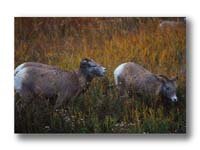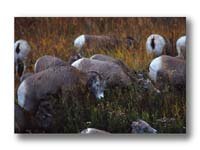
All Images And Text On This Site Are Copyright 1999-2000
by
Thomas D. Hill Jr.
| ABOUT KEIKO |
| WHAT'S NEW |
| THE KEIKO GALLERY |
| EQUIPMENT |
| IMAGE OF THE MONTH |
| ARTICLE OF THE MONTH |

Image a species with the agility of a gymnast, the body of a NFL linebacker, and the climbing abilities of world class mountain climber. What you're imaging is a Big Horn Sheep. One of the most wondrous animals in North America and one of the easiest to photography.
Big Horn Sheep can be found in most of the Rocky Mountains. Unfortunately locations that used to have large herds are now less common. Some of the species of this magnificent animal are now endangered. Still, there are many locations where they're seen with incredible reliability. They're especially common throughout the Canadian Rockies and are easily seen throughout the Canada's Mountain Parks such as Banff and Jasper.
Big Horn Sheep are social animals. Ewe's and young males less than two years old herd together in groups as large as 15-30 animals. Older males congregate in small bachelor groups throughout most of the year. Rarely do the two groups come together except in the middle fall when the rut begins--which is a sight to behold. With such large groups, there's typically excellent opportunities to watch and photograph interactions between a group's members. The Ewe groups tend to be more gregarious while the big males are more stoic. Still, each group offers unique photographic opportunities which I'll discuss in a bit.

Finding Big Horn Sheep in Canada's mountain parks can be as simple as watching the road sides. Most of the common locations have been posted with reduced speed zones and "watch for wildlife" signs to caution motorists . It seems sheep have little fear of man and his machines and will think nothing of walking in front of an oncoming semi-tractor trailer. A word of the wise for both theirs and your safety is to strictly pay attention to those signs. Other prime locations for sheep are public parking lots and such. As majestic as they are, Big Horn Sheep are excellent at mooching a treat or two. At many locations, small groups of sheep will hang out in the parking lots waiting for cars to arrive. Barely after shutting off his motor, a visitor may be greeted by a pair of big sheep eyes staring you down for a quick snack. Unfortunately, this behavior is encouraged by the thousands of folks that don't perceive their little potato chip is going to matter. After all, they may think it's only one chip. Well, one little chip is actually the tip of the iceberg. Sheep have learned to hang out in numbers in particular areas because of the high reliability of receiving handouts. The worse part of this whole practice is sheep are endangered by other motor vehicles when they're mooching along the road. Also, there's evidence the poor nutritional value of most snack food is reducing the survival ability of the sheep. Herds are getting smaller at some locations and these little potato chips may be the blame.
As a photographer, you'll have little problem approaching these "tame" city sheep in these public settings. They have little fear of humans probably because they've never had a reason for it. They've been "impressed" with the general benefits of hanging around humans. Be advised, non-parking lot animals--country sheep--do not have this demeanor. They are very shy and you may find approaching them to be extremely difficult.
I photograph Big Horn Sheep two ways--from my vehicle, or by approaching them on foot. Both are extremely productive depending on the situation. City sheep are approachable whether on foot or vehicle but despite their relative tame nature they are still wild animals. Once while photographing a bachelor group on the side of a small ridge, I positioned myself about 100 ft away at the bottom of the slope. Confident that I wasn't approaching too closely or causing them undue stress, I continued with my work. Without warning, the group came crashing down the slope at a full run almost directly towards me. They passed only 10 feet away. Obviously, something spooked them which forced them into a run. A bit shaken, I came to the conclusion that if one of these males wanted to go through the piece of ground I was standing on, he wouldn't have adjusted his course one bit. I would've been the one to either get out of the way or suffer the consequences. Somehow I don't think my 500mm lens was going to be much help against a Big Horned Sheep's hard head. These guys deserve all the respect we can give them.

My favorite film for shooting these guys is either Velvia or Provia F--both work wonderfully. I have to give a nod to Velvia because of it's saturated colors. This is especially true when shooting during the fall when the colors are especially brilliant. However, Provia should still hold its own under the same conditions. Also, it pushes better than Velvia does.
I don't use any special metering techniques when shooting Big Horn Sheep. They're mostly neutral colors and don't require any metering compensation techniques. Like most situations, I only compensate for unusual background characteristics such as dark or light areas. However, a word of caution when photographing a brightly lit sheep against a dark background. Their white rumps are very reflective and can easily "blowup" if you're not careful.
You're lens choice is totally dependent on how close you can get. I love taking tight portraits of these guys but larger environment shots will show more social interaction and can be more interesting to the viewer. When shooting the youngsters, be ready for the unexpected. When crossing small streams, young will sometimes attempt to jump across instead of walking like their mothers and older siblings. As always with wildlife, expect the unexpected
I've found endless hours of enjoyment shooting Big Horn Sheep. Where they live, they can be quite easy to find, approach, and photograph. There's a word of caution with them as well as any wild animal. Even though they look docile, they can change their demeanor at a moments notice. Still, their social nature and majestic nature make them outstanding additions to any portfolio.
